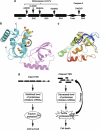Metacaspases
- PMID: 21597462
- PMCID: PMC3172103
- DOI: 10.1038/cdd.2011.66
Metacaspases
Abstract
Metacaspases are cysteine-dependent proteases found in protozoa, fungi and plants and are distantly related to metazoan caspases. Although metacaspases share structural properties with those of caspases, they lack Asp specificity and cleave their targets after Arg or Lys residues. Studies performed over the past 10 years have demonstrated that metacaspases are multifunctional proteases essential for normal physiology of non-metazoan organisms. This article provides a comprehensive overview of the metacaspase function and molecular regulation during programmed cell death, stress and cell proliferation, as well as an analysis of the first metacaspase-mediated proteolytic pathway. To prevent further misapplication of caspase-specific molecular probes for measuring and inhibiting metacaspase activity, we provide a list of probes suitable for metacaspases.
Figures


Similar articles
-
A plant alternative to animal caspases: subtilisin-like proteases.Cell Death Differ. 2011 Aug;18(8):1289-97. doi: 10.1038/cdd.2011.49. Epub 2011 May 6. Cell Death Differ. 2011. PMID: 21546909 Free PMC article. Review.
-
Caspases in plants: metacaspase gene family in plant stress responses.Funct Integr Genomics. 2015 Nov;15(6):639-49. doi: 10.1007/s10142-015-0459-7. Epub 2015 Aug 16. Funct Integr Genomics. 2015. PMID: 26277721 Review.
-
Regulating Death and Disease: Exploring the Roles of Metacaspases in Plants and Fungi.Int J Mol Sci. 2022 Dec 24;24(1):312. doi: 10.3390/ijms24010312. Int J Mol Sci. 2022. PMID: 36613753 Free PMC article. Review.
-
Evolution and structural diversity of metacaspases.J Exp Bot. 2019 Apr 12;70(7):2039-2047. doi: 10.1093/jxb/erz082. J Exp Bot. 2019. PMID: 30921456 Review.
-
Metacaspases-Like Proteases of Trichomonas vaginalis: In Silico Identification and Characterization.J Basic Microbiol. 2025 Jun;65(6):e2400786. doi: 10.1002/jobm.202400786. Epub 2025 Jan 26. J Basic Microbiol. 2025. PMID: 39865582
Cited by
-
Plasmodium vivax metacaspase 1 (PvMCA1) catalytic domain is conserved in field isolates from Brazilian Amazon.Mem Inst Oswaldo Cruz. 2021 May 31;116:e200584. doi: 10.1590/0074-02760200584. eCollection 2021. Mem Inst Oswaldo Cruz. 2021. PMID: 34076074 Free PMC article.
-
Inhibition of cathepsin B by caspase-3 inhibitors blocks programmed cell death in Arabidopsis.Cell Death Differ. 2016 Sep 1;23(9):1493-501. doi: 10.1038/cdd.2016.34. Epub 2016 Apr 8. Cell Death Differ. 2016. PMID: 27058316 Free PMC article.
-
Genome-Wide Identification and Expression Analysis of the Metacaspase Gene Family in Gossypium Species.Genes (Basel). 2019 Jul 12;10(7):527. doi: 10.3390/genes10070527. Genes (Basel). 2019. PMID: 31336941 Free PMC article.
-
Autophagy and metacaspase determine the mode of cell death in plants.J Cell Biol. 2013 Dec 23;203(6):917-27. doi: 10.1083/jcb.201307082. J Cell Biol. 2013. PMID: 24344187 Free PMC article.
-
Grapevine VpPR10.1 functions in resistance to Plasmopara viticola through triggering a cell death-like defence response by interacting with VpVDAC3.Plant Biotechnol J. 2018 Aug;16(8):1488-1501. doi: 10.1111/pbi.12891. Epub 2018 Mar 8. Plant Biotechnol J. 2018. PMID: 29377445 Free PMC article.
References
-
- Uren AG, O'Rourke K, Aravind L, Pisabarro MT, Seshagiri S, Koonin EV, et al. Identification of paracaspases and metacaspases: two ancient families of caspase-like proteins, one of which plays a key role in MALT lymphoma. Mol Cell. 2000;6:961–967. - PubMed
-
- Aravind L, Koonin EV. Classification of caspase-hemoglobinase fold: detection of new families and implications for the origin of eukaryotic separins. Proteins. 2002;46:355–367. - PubMed
-
- Szallies A, Kubata BK, Duszenko M. A metacaspase of Trypanosoma brucei causes loss of respiration competence and clonal death in the yeast Saccharomyces cerevisiae. FEBS Lett. 2002;517:144–150. - PubMed
-
- Vercammen D, van de Cotte B, De Jaeger G, Eeckhout D, Casteels P, Vandepoele K, et al. Type II metacaspases Atmc4 and Atmc9 of Arabidopsis thaliana cleave substrates after arginine and lysine. J Biol Chem. 2004;279:45329–45336. - PubMed
Publication types
MeSH terms
Substances
Grants and funding
LinkOut - more resources
Full Text Sources
Other Literature Sources
Miscellaneous

